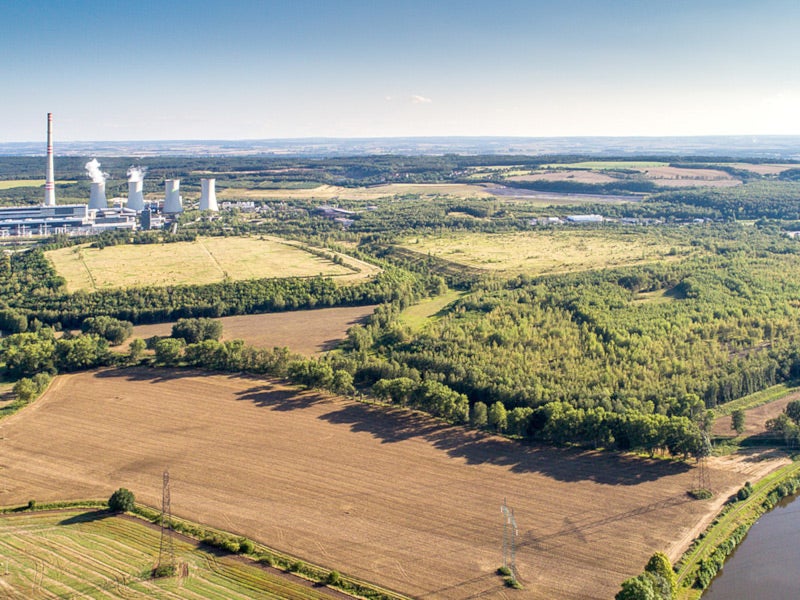The Chvaletice manganese project located 90km away from Prague, Czech Republic, is considered to be the biggest manganese deposits in Western Europe.
The project involves re-processing of fine-grained tailings present in three tailings cells. The tailings are a result of historical open-pit mining operations and processing of pyrite from 1951 to 1975.
Mangan Chvaletice, a wholly-owned Czech subsidiary of Euro Manganese (EMN), is the project developer. It is expected to produce ultra-high-purity manganese products for the lithium-ion battery industry based in Europe.
Preliminary economic assessment (PEA) of the Chvaletice manganese project was completed in January 2019. Feasibility study on the project is expected to be completed by early-2020, while commercial operations are anticipated to be commenced by 2022.
The Chvaletice manganese project is expected to produce more than 1.19 million tons (Mt) of high-purity electrolytic manganese metal (HPEMM) through its estimated operational life of 25 years.
Chvaletice manganese project background
The manganese deposits at the Chvaletice project site were first discovered in the 1800s. Mining activities at the site were conducted during the mid-1900s. The recovered manganese was supplied to the steel mills based in Czechoslovakia and Germany.
Bateria Slany, a Czechoslovakian state-owned battery producer, conducted exploration in the region in the late-1980s.
Mangan Chvaletice, a consortium established by GET, Geomin, and Orex Consultants, secured exploration rights for the project in September 2014.
EMN acquired Mangan Chvaletice in May 2016 and commenced exploration drilling activities in 2017.
EMN entered a conditional sales and purchase agreement with the Municipality of Trnavka for the purchase of a 2.96ha land strip, thus expanding the project area.
Chvaletice manganese project location, geology, and mineralisation
The Chvaletice manganese project is located in the western area of the Pardubice region, Czech Republic, and is in close proximity with the southern shore of the Labe River.
The brownfield project is situated within the industrial park, which once hosted the historical tailings processing plant.
The original Chvaletice bedrock deposit is situated at a distance of approximately 1km from the project. The bedrock is Proterozoic in age and is made up of deformed granitic crystalline and overlain meta-sedimentary rocks of the Bohemian Massif.
Majority of the reserves are hosted within the three adjacent flotation tailing piles, deposited on the flat terrain underground below the floatation mill plant.
The geology of the deposit tailings includes fine greyish to sandy material comprising approximately 7.3% of manganese. The mineralisation mostly occurs in the rhodochrosite and kutnohorite forms of manganese carbonates.
Chvaletice manganese project reserves
The Chvaletice manganese project is estimated to contain measured and indicated tailing resources of 27Mt, graded at 7.33% of total manganese, as of January 2019.
Mining and ore processing
The recycling of tailings does not require any hard rock mining, crushing or milling. The processing plant will be a part of the industrially-zoned brownfields site, which also houses the historical Chvaletice processing plant.
Mangan Chvaletice proposes to employ shovel excavators extract the tailings and truck them to an intermediate re-pulping and surge pile/storage station.
The processing plant will have an annual capacity to produce 48,000t of HPEMM from approximately 1.1Mt of tailings extracted from the mine. Approximately two-third of the HPEMM produced from the processing plant will be converted into 100,000t of high-purity manganese sulfate monohydrate (HPMSM) a year.
The plant will comprise the magnetic separation facility, magnetic concentrate dewatering facility, leaching facility, and pregnant solution purification facility. It will also include facilities for HPEMM electro-winning, passivation, stripping, packing, and storage.
The final saleable product is expected to contain 404,100 tonnes (t) of HPEMM and 2.35 million tonnes (Mt) of HPMSM.
The CMP HPMSM product is expected to contain a minimum of 99.9% manganese sulfate monohydrate (MSM) and 32.34% manganese. It will be sold in powder form, produced without the use of fluorine.
Infrastructure facilities at Chvaletice
The site is located along Highway 322, which is connected to Prague. The site consists of several existing railway spur lines connected to Prague, which is linked to the communities in the Eastern Czech Republic through a railway transportation line.
Power supply for the project will be provided by two independent 110kV transmission lines connected to the Czech national grid network.
Fresh water will be collected either from the local water supply system or from the Labe River, and stored in a 1,000m³ water tank. Site run-off water and the Labe River, or other local water sources will be the source of process make-up water for the project.
Contractors involved with the project
Tetra Tech Canada prepared the PEA of the project, with inputs from Bilfinger Tebodin Czech Republic, CINF Engineering, and GET.
Tetra Tech Canada was also engaged as the owner’s engineer and will oversee the work of various consultants and service providers with regards to the feasibility study report of the project.
Bilfinger Tebodin is responsible for initiating the preparation of the description and notification of the project required for obtaining environmental approval.





